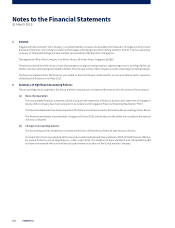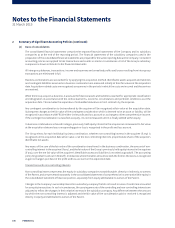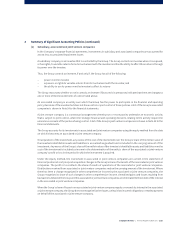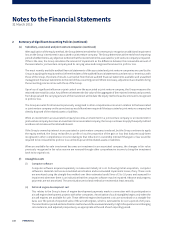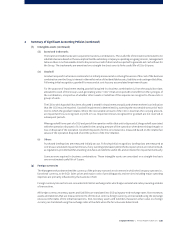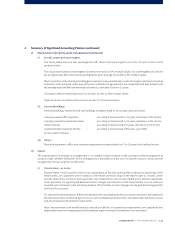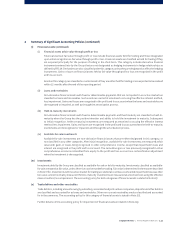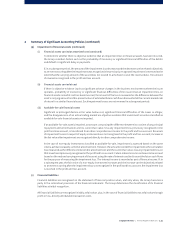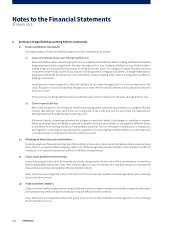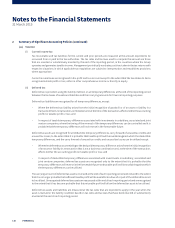Singapore Airlines 2015 Annual Report Download - page 114
Download and view the complete annual report
Please find page 114 of the 2015 Singapore Airlines annual report below. You can navigate through the pages in the report by either clicking on the pages listed below, or by using the keyword search tool below to find specific information within the annual report.
Notes to the Financial Statements
31 March 2015
2 Summary of Significant Accounting Policies (continued)
(j) Leases (continued)
(ii) Operating lease – as lessee
Leases where the lessor eectively retains substantially all the risks and benefits of ownership of the leased assets
are classified as operating leases. Operating lease payments are recognised as an expense in the profit and loss
account on a straight-line basis over the lease term. The aggregate benefit of incentives provided by the lessor is
recognised as a reduction of rental expense over the lease term on a straight-line basis.
Gains or losses arising from sale and operating leaseback of aircra are determined based on fair values. Excess of
sales proceeds over fair values are taken to the statement of financial position as deferred gain on sale and leaseback
transactions, included under deferred account and amortised over the minimum lease terms. If the sales proceeds
are below fair values, the loss is recognised in the profit and loss account except that, if the loss is compensated
for by future lease payments at below market values, the deferred loss is included under deferred account and is
amortised over the minimum lease period.
Major improvements and modifications to leased aircra due to operational requirements are capitalised and
depreciated over the remaining lease term period or the average expected life between major overhauls (estimated
to be 4 to 10 years).
(iii) Operating lease – as lessor
Leases where the Group retains substantially all the risks and rewards of ownership of the asset are classified as
operating leases. Aircra leased out under operating leases are included under property, plant and equipment
and are stated at cost less accumulated depreciation and accumulated impairment losses, if any. Rental income is
recognised on a straight-line basis over the lease term.
(k) Inventories
Inventories are stated at the lower of cost and net realisable value. Cost is determined on a weighted average basis. Net
realisable value is the estimated selling price in the ordinary course of business less estimated costs necessary to make
the sale. Where necessary, allowance is provided for damaged, obsolete and slow moving items to adjust the carrying
value of inventories to the lower of cost and net realisable value.
(l) Financial assets
Financial assets are recognised on the statement of financial position when, and only when, the Group becomes a party
to the contractual provisions of the financial instrument. The Group determines the classification of its financial assets
at initial recognition.
When financial assets are recognised initially, they are measured at fair value, plus, in the case of financial assets not at
fair value through profit or loss, directly attributable transaction costs.
A financial asset is derecognised where the contractual right to receive cash flows from the asset has expired. On derecognition
of a financial asset in its entirety, the dierence between the carrying amount and the sum of the consideration received
and any cumulative gain or loss that had been recognised in other comprehensive income is recognised in the profit and
loss account.
All regular purchases and sales of financial assets are recognised or derecognised on the trade date, i.e., the date that the
Group commits to purchase or sell the asset. Regular way purchases or sales are purchases or sales of financial assets that
require delivery of assets within the period generally established by regulation or convention in the marketplace concerned.
112 FINANCIAL




